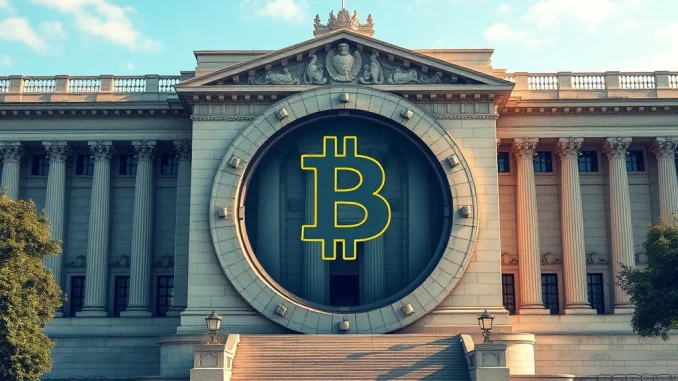
Imagine a world where the U.S. government views Bitcoin not as something to be immediately liquidated, but as a crucial national asset, much like gold or strategic oil reserves. Well, that future is no longer a distant dream. In a monumental shift, the United States has officially established a Strategic Bitcoin Reserve, fundamentally altering its approach to digital asset management. This groundbreaking move, initiated by an executive order, signals a new era for US Bitcoin Policy, recognizing the cryptocurrency’s potential as a long-term strategic holding rather than just a seized commodity.
What Does the New Strategic Bitcoin Reserve Mean for the Market?
The establishment of a Strategic Bitcoin Reserve marks a pivotal moment in the integration of cryptocurrencies into national economic frameworks. Announced via an executive order in March 2025, this initiative reclassifies federally seized Bitcoin – assets previously destined for immediate sale – as a strategic asset to be held for the long term. This isn’t just a bureaucratic change; it’s a profound re-evaluation of Bitcoin’s role.
Historically, when law enforcement agencies seized Bitcoin from illicit activities, these holdings were typically auctioned off to recover funds. This new policy, championed by figures like President Trump and Senator Cynthia Lummis, halts these immediate sales. Instead, these digital assets will now be managed under a secure account framework, ensuring their “orderly and strategic management.”
The implications for market dynamics are significant. By ceasing immediate sales, the government removes a potential source of selling pressure from the market. Reduced circulating supply could theoretically influence price volatility and trading volumes, potentially leading to greater stability or even upward price pressure in the long run. Gerald Dwyer, a former Federal Reserve official, highlighted that this focus on prolonged retention aligns with viewing Bitcoin as a strategic hedge against inflation and a tool for economic diversification.
Is Bitcoin Truly the “Digital Gold” of the Future?
The U.S. government’s decision to treat Bitcoin as a reserve asset draws clear parallels to its historical management of gold. For decades, gold has been considered a traditional safe-haven asset, a hedge against economic instability and inflation. By positioning Bitcoin as a “Digital Gold” analog, the U.S. is acknowledging its potential to serve a similar function in the digital age.
Why this comparison? Like gold, Bitcoin has a finite supply, making it inherently scarce. It operates outside the direct control of any single government or financial institution, offering a degree of decentralization and censorship resistance that appeals to those seeking an alternative to fiat currencies. In times of economic uncertainty, investors often flock to assets perceived as stores of value, and Bitcoin is increasingly being seen in this light.
Analysts note that while the direct impact on decentralized finance (DeFi) collateral mechanisms remains uncertain due to limited data, the underlying philosophy of the Strategic Bitcoin Reserve mirrors past U.S. Treasury interventions, such as gold reserve policies. This strategic shift underscores a growing global trend. Fidelity, for instance, projected that more governments would follow the U.S. example in 2025, with Bitcoin becoming a “significant” reserve asset globally.
How Will New Crypto Regulation Shape the Digital Asset Landscape?
The establishment of the Strategic Bitcoin Reserve doesn’t happen in a vacuum; it’s part of a broader, concerted effort to integrate cryptocurrencies into the nation’s economic infrastructure. This includes significant legislative advancements, such as the GENIUS Act. This landmark legislation aims to codify regulatory structures for stablecoins and clarify federal oversight roles, providing much-needed clarity in a rapidly evolving space.
The push for comprehensive Crypto Regulation is driven by a desire to foster innovation while mitigating systemic risks. While the executive order provides a framework for Bitcoin, the GENIUS Act addresses stablecoins, which are seen as a bridge between traditional finance and the crypto world. Major banks like JPMorgan and Bank of America are already exploring stablecoin integration, signaling the mainstreaming of these digital assets.
However, challenges persist. Banking associations have voiced caution against expedited approvals for stablecoin charters, urging further evaluation of potential systemic risks. Meanwhile, ongoing legislative efforts like the House’s Digital Asset Market Clarity Act and various Senate proposals aim to address remaining oversight gaps, with key negotiations expected by late September. The goal is to strike a balance between enabling technological advancement and ensuring financial stability and consumer protection.
What Are the Broader Implications of This US Bitcoin Policy?
The new US Bitcoin Policy has wide-ranging implications, extending beyond just government holdings. It signals a strong endorsement of digital assets from the highest levels of government, which can bolster confidence among private investors and institutions. This public-private collaboration is already evident.
For example, Trump Media & Technology Group (DJT) announced a significant $2 billion Bitcoin investment in July 2025. This move reinforces the administration’s emphasis on crypto as a cornerstone of financial strategy and demonstrates private sector alignment with the government’s newfound appreciation for digital assets. Such high-profile investments can influence market sentiment and accelerate broader adoption.
Globally, the U.S. move sets a precedent. As one of the world’s leading economies, its formal recognition of Bitcoin as a strategic reserve asset could encourage other nations to explore similar policies. This could lead to a domino effect of institutional adoption, further legitimizing Bitcoin and other digital assets on the international stage. The shift from liquidation to long-term stewardship could also reduce market volatility by removing large, unpredictable sales of seized assets.
Navigating the Future: Bitcoin as a Strategic Asset for National Security?
By formalizing Bitcoin as a strategic asset, the U.S. government signals confidence in its role within the evolving financial ecosystem, potentially even viewing it through a lens of national economic security. This perspective suggests that maintaining a reserve of decentralized, digitally native assets could provide a hedge against geopolitical risks, currency debasement, or even cyber warfare.
However, the long-term success of the Strategic Bitcoin Reserve will depend on several critical factors. Transparency in asset management is paramount to building public trust and ensuring accountability. How these assets are secured, valued, and potentially utilized (or not utilized) will be under close scrutiny. Critics argue that balancing innovation with stability will be crucial, particularly as traditional institutions navigate the regulatory and technological complexities inherent in this new frontier.
The U.S. move aligns with international efforts to leverage digital assets for economic security, and its execution will serve as a model for other nations. As the world increasingly digitizes, the strategic management of digital assets like Bitcoin could become as important as managing physical reserves. The future of finance is undoubtedly becoming more intertwined with digital currencies, and the U.S. has just taken a monumental step to secure its place in that future.
The U.S. government’s decision to establish a Strategic Bitcoin Reserve marks a truly transformative moment for the cryptocurrency space. By reclassifying seized Bitcoin from a liquidated asset to a long-term strategic holding, the nation has embraced a forward-thinking US Bitcoin Policy that views Bitcoin as a modern-day “Digital Gold” and a vital strategic asset. This move, coupled with ongoing efforts in Crypto Regulation, not only legitimizes Bitcoin further but also sets a powerful precedent for institutional and governmental adoption worldwide. While challenges remain in balancing innovation with stability, this pivotal shift underscores a clear commitment to integrating digital assets into the very fabric of the nation’s economic future. The world is watching, and the implications for global finance are profound.
Frequently Asked Questions (FAQs)
Q1: What is the U.S. Strategic Bitcoin Reserve?
The U.S. Strategic Bitcoin Reserve is a new initiative, established by an executive order in March 2025, that reclassifies federally seized Bitcoin as a long-term strategic reserve asset. Instead of liquidating these holdings, the government will now hold them under a secure account framework, signaling a shift towards long-term stewardship of digital assets.
Q2: How does this new policy differ from previous U.S. approaches to seized Bitcoin?
Previously, the U.S. government typically auctioned off or liquidated seized Bitcoin holdings to recover funds. The new policy, however, halts these immediate sales, opting instead to retain these assets as a strategic reserve, much like gold or other national reserves. This reflects a fundamental change in how the U.S. views and manages digital assets.
Q3: Why is Bitcoin being compared to “Digital Gold” in this context?
Bitcoin is being compared to “Digital Gold” because, like gold, it is seen as a scarce, decentralized store of value that can act as a hedge against inflation and economic instability. Its finite supply and independence from traditional financial systems make it an attractive asset for long-term holding, similar to how gold has historically been used as a strategic reserve.
Q4: What is the GENIUS Act, and how does it relate to this Bitcoin policy?
The GENIUS Act is a legislative advancement that aims to codify regulatory structures for stablecoins and clarify federal oversight roles for cryptocurrencies. While the Strategic Bitcoin Reserve focuses on Bitcoin holdings, the GENIUS Act is part of the broader effort to establish comprehensive crypto regulation, ensuring stability and clarity across the digital asset landscape.
Q5: What are the potential market implications of the Strategic Bitcoin Reserve?
The potential market implications include reduced selling pressure from government liquidations, which could influence Bitcoin’s price volatility and trading volumes. By removing a source of unpredictable supply, the policy might contribute to greater market stability. It also signals strong governmental endorsement, potentially boosting institutional and private sector confidence in Bitcoin.
Q6: Will other countries follow the U.S. example in creating Bitcoin reserves?
Analysts, including those from Fidelity, project that more governments are likely to follow the U.S. example in 2025, with Bitcoin becoming a “significant” reserve asset globally. The U.S. move sets a precedent that could encourage other nations to explore similar policies for digital asset management and economic security.



